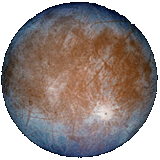
Europa (IPA: [juˈroʊpə] listen ; Greek Ευρώπη) is the sixth nearest and fourth largest natural satellite of the planet Jupiter. Europa was discovered in 1610 by Galileo Galilei (and independently by Simon Marius shortly thereafter) and is the smallest of the four Galilean moons named in Galileo's honor.
Europa is primarily composed of silicate rock, has an outer layer of water, and likely has an iron core. At just over 3000 kilometers in diameter, it is slightly smaller than the Earth's moon and the sixth largest moon in the solar system. The satellite has a very tenuous oxygen atmosphere and one of the smoothest surfaces in the solar system. The young surface of the planet is straited by cracks and streaks, while craters are relatively infrequent. Due to an hypothesized water ocean beneath its icy surface, and an energy source provided by tidal heating, Europa has been cited as a possible host of extraterrestrial life.
 Discovery and naming
Discovery and namingEuropa orbits Jupiter in just over three and a half days, with an orbital radius of about 670,900 km (416,900 mi). The satellite follows a very nearly circular orbit, with an eccentricity of only 0.009. Europa's orbital inclination relative to the Jovian equatorial plane is also slight, at 0.470°.
Because of its orbit's slight eccentricity, maintained by the gravitational disturbances from the other Galilean satellites of the planet, the sub-jovian point oscillates about a mean position. Europa strives to assume a slightly elongated shape pointing towards Jupiter in response to the tidal force of the giant planet; because different parts of Europa end up being on different points of this departure from sphericity at varying times, the crust flexes up and down. This motion dissipates energy from Jupiter's rotation into Europa (tidal heating), giving the moon a source of heat and energy, allowing the subsurface ocean to stay liquefied and driving subsurface geological processes.
Orbit
Physical characteristics
Europa is somewhat similar in bulk composition to the terrestrial planets, being primarily composed of silicate rock. It has an outer layer of water thought to be around 100 km thick (some, as frozen ice upper crust; some, as liquid ocean underneath the ice), and recent magnetic field data from the Galileo orbiter probe, which orbited Jupiter and studied Europa between 1995 and 2003, shows that Europa generates an induced magnetic field by interacting with Jupiter's field, which suggests the presence of a subsurface conductive layer which is likely a salty liquid-water ocean. Europa probably also contains a metallic iron core.
Internal structure
The Europan surface is relatively smooth; few features more than a few hundred metres high have been observed, but topographic relief in places approaches a kilometre (0.62 mi)). Cynthia Phillips, a member of SETI and an expert on Europa states there is currently no consensus among the often contradictory explanations for the surface features of Europa.[2]
Surface features
 Lefthit
Lefthit